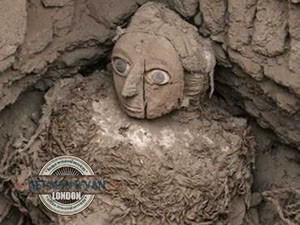Six remarkable archaeological discoveries
For centuries archaeologists have made a number of important discoveries which have changed our understanding of the past. This is why we have decided to write down an article with some the most important archaeological discoveries ever made.
 La Dama de la Mascara (the Mask Lady) – Also known as the Wari Masked Mummy, this archaeological discovery was made in 2008 by Peruvian archaeologists. The mummy was found in the Miraflores District in Lime, the capital of Peru and dates back to the 4th century. It was discovered with several knitting and weaving relics which meant that she was probably the chief of the weavers. However the blue eyed wooden mask that covered the mummy’s face was arguably the most important artifact of the discovery.
La Dama de la Mascara (the Mask Lady) – Also known as the Wari Masked Mummy, this archaeological discovery was made in 2008 by Peruvian archaeologists. The mummy was found in the Miraflores District in Lime, the capital of Peru and dates back to the 4th century. It was discovered with several knitting and weaving relics which meant that she was probably the chief of the weavers. However the blue eyed wooden mask that covered the mummy’s face was arguably the most important artifact of the discovery.
- 3.000 year old Hebrew text – In 2008 a group of archaeologists discovered a three millennia old Hebrew text in Jerusalem. The text comprised of eight letters and described the content of a jar as wine. The ancient wine label dates back to the 10th century B.C which means that it was created during reign of King Solomon.
- Staffordshire Hoard – Known as the Anglo-Saxon Gold Hoard it consists of over 3.500 items and is the largest hoard of gold and silver metalwork found to date. The discovery was made in 2009 in Staffordshire in the central parts of England. Experts have dated to relics to the 7th and 8th centuries which mean that the artifacts originate from the Anglo-Saxon kingdom of Mercia. The hoard is currently displayed in two museums, the Birmingham Museum and Art Gallery and the Potteries Museum and Art Gallery.
- Rosetta Stone – The Rosetta Stone was discovered by French soldiers near the city of Rosetta in Egypt in 1799. The artifact is a granodiorite stele inscribed with a decree in three languages: Ancient Egyptian, Demotic and Ancient Greek. The stone was issued in the city of Memphis and dates back to 196 B.C. The Rosetta Stone is currently displayed in the British Museum and is considered by many to be the most important there. Make sure that you see it with your own eyes once your move to London via man and van services is complete. Don’t worry about the price of man and van services as presently most moving companies work with cost effective prices.
- Tomb of Tutankhamun – This is another archaeological discovery that comes from Egypt. The tomb of the Egyptian pharaoh was discovered in 1922 by Howard Carter and George Herbert, 5th Earl of Carnarvon. Most of the relics that were discovered in the tomb are showcased in the Cairo Museum. The remaining artifacts tour the world constantly and have been displayed in museums all over the planet.
- Lyuba – Lyuba is a female baby woolly mammoth which was discovered in the Yamal Peninsula in Russia in 2007. The mammoth died approximately 41.800 years ago at the age of 30 to 35 days. It is presently the best preserved mammoth mummy in the world. Lyuba is showcased at the Shemanovsky Museum in Salekhard.
About author
-

-
Jeremy Oliver
Previously serving as a logistics coordinator, Jeremy's comprehensive understanding of the industry gives him the ability to translate complex procedures into easy-to-understand blog posts. He has a particular knack for tackling the intricacies of London's removals scene, from the congested roadways to the unique challenges of navigating historic neighborhoods. As an authentic Londoner, Jeremy combines practical knowledge with his inherent love for the city, offering readers not only information on man with van removals but also local insights and valuable tips.

